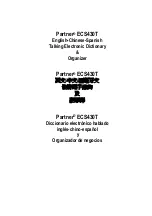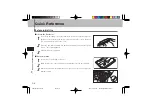
9. History: The story behind the Electro 2 instruments
NORD ELECTRO 2 V2.0x
Page 62
Hohner unleashed the Clavinet C in 1968. This ver-
sion features a slimmer design and better served the
live keyboard player on stage. Its sales shot rocket-
high. In 1971, the Clavinet D6 was launched. It be-
came the most popular model. The D6 sported 15
different filter settings, four different microphone
settings, and a mute function to dampen the strings.
An improved internal string-dampening feature also
reduced the acoustic feedback problem.
The last of the Clavinets -- the E7 -- appeared in
1977. It was especially designed to be taken on the
road by rock bands. The E7's insides were the same
as the D6, with the addition of a special filter to re-
duce interference from light dimmers and other
electric equipment used on stage. Unfortunately,
this filter proved detrimental to the Clavinet's high-
er frequencies, which was a serious drawback for the
sound quality.
At that point, polyphonic synthesizers began ap-
pearing on the market and the Clavinet was no long-
er popular. Its production ended in 1980.
Hohner's Clavinet D6 has a pre-amplifier featuring fou
different filters that can be fixed to 16 different settings
as well as four pick-up variations. In total, there are 64
different sound combinations -- which are all simulated
in the Nord Electro 2.
The four fixed filters are designated Brilliant (high-fre
quency), Treble (high-mid), Medium (mid-low), and
Soft (bass). The Pick-up settings are a combination of the
two pick-ups in the Clavinet. With the B and C buttons
activated, the Bridge pick-up is chosen -- which provide
a warmer sound. When the A and C buttons are activat
ed, the signal is fed through the Neck pick-up, giving a
brighter sound. The combination A and D activates both
microphones, making the sound is more full-bodied. Fi
nally, with the B and D buttons activated, the signal get
routed through the Bridge and Neck pick-ups set out of
phase, resulting in a thinner sound with less fundamen
tal. The knob is the volume controller.
Under the Clavinet's hood. In the front, you'll notice the damping mechanism af-
ter the Neck pick-up. Beneath the keys under the strings, you can see the Bridge
pick-up. The strings are mounted on a metal body that's fastened into the wood
cabinet.
This is the lowest key on a Clavinet D6. The green material is yarn, which serves
to dampen and avoid feedback. The little round detail under the key is the tan-
gent with the rubber tip that hits the string. Underneath the string is an anvil.
The Clavinet strings are more plucked than struck.
Directly from the front. The hammers are mounted beneath the keys. Each ham-
mer has a rubber tip that hits a string. Each tangent has a corresponding anvil
beneath the string. When the tangent hits a string, the string will vibrate. The
screws serve to tune the strings.







































